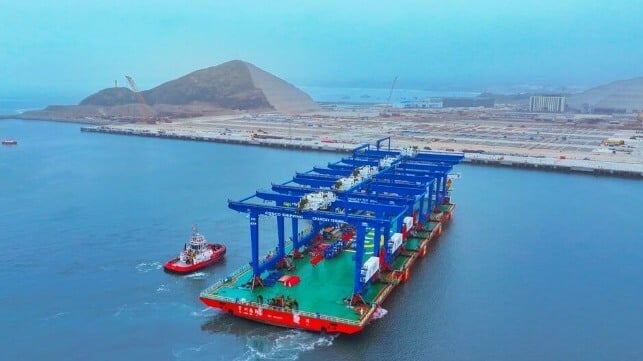China's Navy Could Use Peru's New Mega-Port

COSCO Shipping is about to commence a soft opening of its newly-constructed container terminal in Chancay, 50 miles north of Peru’s capital Lima. Despite attempts to frustrate this by Peru’s government, COSCO is set to be the sole operator. The terminal is more than 90% complete, initially with four operating berths.
The port is expected to be formally opened by Chinese President Xi Jinping on 14 November, when he is scheduled to attend the Asia-Pacific Economic Cooperation forum. For security reasons the Chinese president will open the port remotely via video link from the safety of the Chinese Embassy in Lima.
COSCO intends that the port will act as a distribution node for trans-Pacific trade, with smaller ships taking containers onwards to Chile, Colombia, Ecuador and other ports on South America’s west coast. There are even hopes that it will cater to areas of Brazil that are too far inland to be effectively served by ports on the Atlantic.
In its start-up phase, COSCO or its Ocean Alliance partners will operate two 14,000 TEU container ships per week, direct to Shanghai. COSCO intends that when fully developed, Chancay will be able to handle larger vessels handling 24,000 TEU containers.
The project has been financed by a consortium of Chinese banks, with the investment totalling US$3.5 billion when fully complete. It appears likely to be one of the more successful deliverables of the faltering Belt and Road Initiative, which elsewhere has seen host countries saddled with debts which the Chinese have been reluctant to reschedule, with the Chinese then taking full ownership and control of the facilities instead.
The imminent opening of the port has attracted comment from General Laura Richardson, Commander of US Southern Command, who has expressed concern that the deep-water characteristics of the new port will make it suitable for Chinese naval deployments, in particular as a base for forward-deployed intelligence-gathering activities. The port will also be useful in continuing attempts by China to establish a monopoly position in the rare earth minerals trade, which it is seeking to consolidate by buying stakes in mining companies in South America. Chinese attempts to also establish an operating footprint in Ushuaia in southern Argentina appear to have been thwarted after General Richardson visited Ushuaia in April this year.
